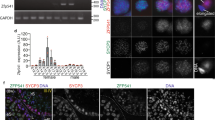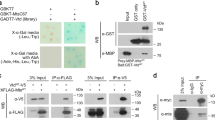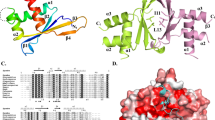Abstract
Boule, a Drosophila orthologue of the vertebrate Dazl fertility factors, is a testis-specific regulator of meiotic entry and germline differentiation. Mutations inactivating either Boule, which is an RNA-binding protein, or Twine, which is a Cdc25-type phosphatase, block meiotic entry in males. Here we show that twine and boule interact genetically. We also find that protein expression from twine messenger RNA correlates with cytoplasmic accumulation of Boule and is markedly reduced by boule mutations. Remarkably, heterologous expression of Twine rescues the boule meiotic-entry defect, indicating that the essential function of Boule at the transition from G2 to M phase during meiosis is in the control of Twine translation.
This is a preview of subscription content, access via your institution
Access options
Subscribe to this journal
Receive 12 print issues and online access
$209.00 per year
only $17.42 per issue
Buy this article
- Purchase on Springer Link
- Instant access to full article PDF
Prices may be subject to local taxes which are calculated during checkout





Similar content being viewed by others
References
Alphey, L. et al. twine, a cdc25 homolog that functions in the male and female germline of Drosophila. Cell 69, 977–988 (1992).
Courtot, C., Fankhauser, C., Simanis, V. & Lehner, C. F. The Drosophila cdc25 homolog twine is required for meiosis. Development 116, 405–416 (1992).
White-Cooper, H., Schafer, M. A., Alphey, L. S. & Fuller, M. T. Transcriptional and post-transcriptional control mechanisms coordinate the onset of spermatid differentiation with meiosis I in Drosophila. Development 125, 125–134 (1998).
Sigrist, S., Ried, G. & Lehner, C. F. Dmcdc2 kinase is required for both meiotic divisions during Drosophila spermatogenesis and is activated by the Twine/cdc25 phosphatase. Mech. Dev. 53, 247–260 (1995).
Eberhart, C. G. & Wasserman, S. A. The pelota locus encodes a protein required for meiotic cell division: an analysis of G2/M arrest in Drosophila spermatogenesis. Development 121, 3477–3486 (1995).
Eberhart, C. G., Maines, J. Z. & Wasserman, S. A. Meiotic cell cycle requirement for a fly homologue of human Deleted in Azoospermia. Nature 381, 783–785 (1996).
Reijo, R. et al. Diverse spermatogenic defects in humans caused by Y chromosome deletions encompassing a novel RNA-binding protein gene. Nature Genet. 10, 383–393 (1995).
Reijo, R., Alagappan, R. K., Patrizio, P. & Page, D. C. Severe oligozoospermia resulting from deletions of azoospermia factor gene on Y chromosome. Lancet 347, 1290–1293 (1996).
Ruggiu, M. et al. The mouse Dazla gene encodes a cytoplasmic protein essential for gametogenesis. Nature 389, 74–77 (1997).
Houston, D. W., Zhang, J., Maines, J. Z., Wasserman, S. A. & King, M. L. A Xenopus DAZ-like gene encodes an RNA component of germ plasm and is a functional homologue of Drosophila boule. Development 125, 171–180 (1998).
Cheng, M. H., Maines, J. Z. & Wasserman, S. A. Biphasic subcellular localization of the DAZL-related protein Boule in Drosophila spermatogenesis. Dev. Biol. 204, 567–576 (1998).
Li, K. et al. Drosophila centrosomin protein is required for male meiosis and assembly of the flagellar axoneme. J. Cell Biol. 141, 455–467 (1998).
Castrillon, D. H. et al. Toward a molecular genetic analysis of spermatogenesis in Drosophila melanogaster: characterization of male-sterile mutants generated by single P element mutagenesis. Genetics 135, 489–505 (1993).
Hoyle, H. D. & Raff, E. C. Two Drosophila β-tubulin isoforms are not functionally equivalent. J. Cell Biol. 111, 1009–1026 (1990).
Michiels, F., Buttgereit, D. & Renkawitz-Pohl, R. An 18-bp element in the 5" untranslated region of the Drosophila β-2 tubulin mRNA regulates the mRNA level during postmeiotic stages of spermatogenesis. Eur. J. Cell Biol. 62, 66–74 (1993).
Reijo, R. et al. Mouse autosomal homolog of DAZ, a candidate male sterility gene in humans, is expressed in male germ cells before and after puberty. Genomics 35, 346–352 (1996).
Spradling, A. C. in Drosophila: A Practical Approach (ed. Roberts, D. B.) 175–197 (IRL, Oxford, 1986).
Ausubel, F. M. et al. (eds) Current Protocols in Molecular Biology (John Wiley & Sons, New York, 1994).
Cooley, L., Verheyen, E. & Ayers, K. chickadee encodes a profilin required for intercellular cytoplasm transport during Drosophila oogenesis. Cell 69, 173–184 (1992).
Kemphues, K. J., Raff, E. C., Raff, R. A. & Kaufman, T. C. Mutation in a testis-specific β-tubulin in Drosophila: analysis of its effects on meiosis and map location of the gene. Cell 21, 445–451 (1980).
Cenci, G., Bonaccorsi, S., Pisano, C., Verni, F. & Gatti, M. Chromatin and microtubule organization during premeiotic, meiotic and early postmeiotic stages of Drosophila melanogaster spermatogenesis. J. Cell Sci. 107, 3521–3534 (1994).
Acknowledgements
We thank L. Alphey, H. White-Cooper, C. Lehner, T. Kaufman, B. Raff, M. Cheng and J. Allen for material assistance; and B. Wakimoto, D. Lindsley and C. Zuker for generating, characterizing, and sharing their collection of ethyl methyl sulphonate-induced male-sterile lines. This work was supported by an NIH postdoctoral fellowship (to J.Z.M.) and a grant from the Council for Tobacco Research (to S.A.W.).
Correspondence and requests for materials should be addressed to S.A.W.
Author information
Authors and Affiliations
Corresponding author
Rights and permissions
About this article
Cite this article
Maines, J., Wasserman, S. Post-transcriptional regulation of the meiotic Cdc25 protein Twine by the Dazl orthologue Boule. Nat Cell Biol 1, 171–174 (1999). https://doi.org/10.1038/11091
Received:
Revised:
Accepted:
Published:
Issue Date:
DOI: https://doi.org/10.1038/11091
This article is cited by
-
MiR-320a upregulation improves IL-1β-induced osteoarthritis via targeting the DAZAP1 and MAPK pathways
Journal of Orthopaedic Surgery and Research (2023)
-
Dynamic sex chromosome expression in Drosophila male germ cells
Nature Communications (2021)
-
Pelota-interacting G protein Hbs1 is required for spermatogenesis in Drosophila
Scientific Reports (2019)
-
A role of Pumilio 1 in mammalian oocyte maturation and maternal phase of embryogenesis
Cell & Bioscience (2018)
-
A genetically enhanced sterile insect technique against the fruit fly, Bactrocera dorsalis (Hendel) by feeding adult double-stranded RNAs
Scientific Reports (2017)



